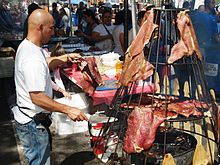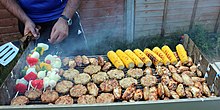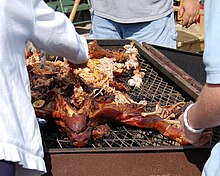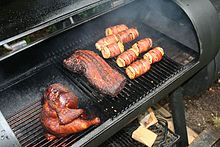Barbecue: Difference between revisions
m Change link to Comparison of American and British English instead of American English, as a comparison is what is discussed. Also general cleanup. using AWB |
→See also: Added Korean BBQ (Gogigui) to the list |
||
| Line 99: | Line 99: | ||
* [[Churrasco]] |
* [[Churrasco]] |
||
* [[Fire pot]] |
* [[Fire pot]] |
||
* [[Gogigui]] |
|||
* [[Hibachi]] |
* [[Hibachi]] |
||
* [[Jamaican jerk spice]] |
* [[Jamaican jerk spice]] |
||
Revision as of 04:09, 3 January 2014
This article has multiple issues. Please help improve it or discuss these issues on the talk page. (Learn how and when to remove these template messages)
|


Barbecue is a method and apparatus for cooking food (generally meat). In the United States, to grill is to cook meat relatively quickly using the direct heat imparted by a charcoal or propane fire, while barbecue is a much slower method utilizing the indirect heat imparted by the smoke of a wood-fueled fire (and tended to over an extended period of several hours).
While there is a vast degree of variation and overlap in terminology and method surrounding this form of cooking, the generally accepted difference between barbecue and grilling is in the cooking time and the type of heat used: grilling is generally done "hot and fast" over direct heat from low-smoke fuels (with the flame contacting the meat itself), while barbecuing is usually done "low and slow" over indirect heat from high-smoke fuels (with the flame not contacting the meat directly).
The term as a noun can refer to the meat or to the cooking apparatus itself (the "barbecue grill" or simply "barbecue"). The term as an adjective can refer to foods cooked by this method. The term is also used as a verb for the act of cooking food in this manner. Barbecue is usually done in an outdoor environment by cooking and smoking the meat over wood or charcoal. Restaurant barbecue may be cooked in large brick or metal ovens specially designed for that purpose. Barbecue has numerous regional variations in many parts of the world.
Etymology
Most etymologists believe that barbecue derives from the word barabicu found in the language of the Taíno people of the Caribbean and the Timucua of Florida, and entered European languages in the form barbacoa. The word translates as "sacred fire pit."[1] The word describes a grill for cooking meat, consisting of a wooden platform resting on sticks.
Traditional barbacoa involves digging a hole in the ground and placing some meat (usually a whole goat) with a pot underneath it, so that the juices can make a hearty broth. It is then covered with maguey leaves and coal and set alight. The cooking process takes a few hours.
It has been suggested that both the word and cooking technique migrated out of the Caribbean and into other languages and cultures, with the word (barbacoa) moving from Caribbean dialects into Spanish, then Portuguese, French, and English. The Oxford English Dictionary cites the first recorded use of the word in the English language as a verb in 1661, in Edmund Hickeringill's Jamaca Viewed: "Some are slain, And their flesh forthwith Barbacu'd and eat." It also appears as a verb in the published writings of John Lederer, following his travels in the American southeast in 1672.[2] The first known use of the word as a noun was in 1697 by the British buccaneer William Dampier. In his New Voyage Round the World, Dampier writes: And lay there all night, upon our Borbecu's, or frames of Sticks, raised about 3-foot (0.91 m) from the Ground.
Samuel Johnson's 1756 dictionary gave the following definitions:[3]
- "To Barbecue – a term for dressing a whole hog" (attestation to Pope)
- "Barbecue – a hog dressed whole"
While the standard modern English spelling of the word is barbecue, local variations like barbeque and truncations such as bar-b-q or bbq may also be found.[4] The spelling barbeque is given in Merriam-Webster and the Oxford English Dictionary as a variant.[5][6]
In the southeastern United States, the word barbecue is used predominantly as a noun referring to roast pork, while in the southwestern states cuts of beef are often cooked.[7]
Styles

In British usage, barbecuing refers to a fast cooking process directly over high heat, while grilling refers to cooking under a source of direct, high heat—known in the United States and Canada as broiling. In American English usage, however, grilling refers to a fast process over high heat, while barbecuing refers to a slow process using indirect heat and/or hot smoke (very similar to some forms of roasting). For example, in a typical U.S. home grill, food is cooked on a grate directly over hot charcoal, while in a U.S. barbecue, the coals are dispersed to the sides or at significant distance from the grate. Its South American versions are the southern Brazilian churrasco and the Argentine asado.[citation needed]
Alternatively, an apparatus called a smoker with a separate fire box may be used. Hot smoke is drawn past the meat by convection for very slow cooking. This is essentially how barbecue is cooked in most U.S. "barbecue" restaurants, but nevertheless, many consider this to be a distinct cooking process called hot smoking.[citation needed]
Barbecuing is a pervasive tradition in much of the world. Almost all competition grillers use charcoal, most often in large, custom designed brick or steel grills. They can range from a few 55 gallon oil drums sawed lengthwise on their sides to make a lid and grill base, to large, vehicle sized grills made of brick, weighing nearly a ton.[citation needed]
American South and Midwest


In the southern United States, barbecue initially revolved around the cooking of pork.[8] During the 19th century, pigs were a low-maintenance food source that could be released to forage for themselves in forests and woodlands. When food or meat supplies were low, these semi-wild pigs could then be caught and eaten.[9]
It was the Spanish who first introduced the pig into the Americas and to the American Indians. The Indians, in turn, introduced the Spanish to the concept of true slow cooking with smoke. The Spanish colonists came to South Carolina in the early 16th century and settled at Santa Elena. It was in that early American colony that Europeans first learned to prepare and to eat "real" barbecue.[10]
According to estimates, prior to the American Civil War, Southerners ate around five pounds of pork for every one pound of beef they consumed.[11] Because of the poverty of the southern United States at this time, every part of the pig was eaten immediately or saved for later (including the ears, feet, and other organs). Because of the effort to capture and cook these wild hogs, pig slaughtering became a time for celebration, and the neighborhood would be invited to share in the largesse.[9] In Cajun culture, these are called boucheries.[citation needed] These feasts are sometimes called 'pig pickin's.' The traditional Southern barbecue grew out of these gatherings.[9]
Each Southern locale has its own particular variety of barbecue, particularly concerning the sauce. North Carolina sauces vary by region; eastern North Carolina uses a vinegar-based sauce, the center of the state enjoys Lexington-style barbecue, which uses a combination of ketchup and vinegar as their base, and western North Carolina uses a heavier ketchup base. Lexington boasts of being "The Barbecue Capital of the World" and it has more than one BBQ restaurant per 1,000 residents.[citation needed] South Carolina is the only state that traditionally includes all four recognized barbecue sauces, including mustard-based, vinegar-based, and light and heavy tomato-based.[10] Memphis barbecue is best known for tomato- and vinegar-based sauces.[12] In some Memphis establishments[12] and in Kentucky, meat is rubbed with dry seasoning (dry rubs) and smoked over hickory wood without sauce; the finished barbecue is then served with barbecue sauce on the side.
The barbecue of Alabama, Georgia, and Tennessee is almost always pork served with a sweet tomato-based sauce. However, several regional variations exist as well. Alabama is particularly known for its distinctive white sauce, a mayonnaise- and vinegar-based sauce, originating in northern Alabama, used predominantly on chicken and pork. A popular item in North Carolina and Memphis is the pulled pork sandwich served on a bun and often topped with coleslaw. Pulled pork is prepared by shredding the pork after it has been barbecued.
Kansas City-style barbecue is characterized by its use of different types of meat (including pulled pork, pork ribs, burnt ends, smoked sausage, beef brisket, beef ribs, smoked/grilled chicken, smoked turkey, and sometimes fish), a variety attributable to Kansas City's history as a center for meat packing in the U.S. Hickory is the primary wood used for smoking in KC, while the sauces are typically tomato based with sweet, spicy and tangy flavor profiles. Burnt ends, the flavorful pieces of meat cut from the ends of a smoked beef or pork brisket, are popular in many Kansas City-area barbecue restaurants.[citation needed]
Pit-beef prevails in Maryland and is often enjoyed at large outdoor "bull roasts", which are common for club or association fundraising events. Maryland-style pit-beef is not the product of barbecue cookery in the strictest sense, as there is no smoking of the meat involved; rather, it involves grilling the meat over a high heat. The meat is typically served rare, with a strong horseradish sauce as the preferred condiment.[13]
The state of Kentucky, particularly Western Kentucky, is unusual in its barbecue cooking, in that the preferred meat is mutton.[14] This kind of mutton barbecue is often used in communal events in Kentucky, such as political rallies, county fairs and church fund-raising events.
In much of the world outside of the American South, barbecue has a close association with Texas. Many barbecue restaurants outside the United States claim to serve "Texas barbecue", regardless of the style they actually serve. Texas barbecue is often assumed to be primarily beef. This assumption, along with the inclusive term "Texas barbecue", is an oversimplification. Texas has four main styles, all with different flavors, different cooking methods, different ingredients, and different cultural origins.
In the midwest, Chicago-style is popular and involves seasoning the meat with a dry rub, searing over a hot grill and a long slow cook in an oven. The meat, typically ribs, are then finished with a sweet-tangy sauce.
Events and gatherings

The word barbecue is also used to refer to a social gathering where food is served, usually outdoors in the late afternoon or evening. In the southern United States, outdoor gatherings are not typically called "barbecues" unless barbecue itself will actually be on the menu, instead generally favoring the word "cookouts". The device used for cooking at a barbecue is commonly referred to as a "barbecue", "barbecue grill", or "grill". In North Carolina, however, "barbecue" is a noun primarily referring to the food and never used by native North Carolinians to describe the act of cooking or the device on which the meat is cooked.[15]
- Often referred to as "The World Series of Barbecue", The American Royal Barbecue Contest[16] is held each October in Kansas City, Missouri. This event comprises two distinct competitions held over the course of four days. The first contest is the Invitational Contest, with competing teams being required to obtain an invitation by winning other qualifying contests throughout the year. The second competition is an open contest that any team can compete in. This open contest is the largest championship barbecue competition in the world, with the 2007 event attracting 496 teams.
- The World Championship Barbecue Cooking Contest is held annually in Memphis, Tennessee, during the Memphis in May festival.[17] According to the Guinness Book of World Records, it is the world's largest pork barbecue contest.[18]
Other barbecue competitions are held in virtually every state in the United States during the warmer months, usually beginning in April and going through September. These events feature keen competitions between teams of cooks and are divided into separate competitions for the best pork, beef and poultry barbecue and for the best barbecue sauces.
Techniques
Barbecuing encompasses four or five distinct types of cooking techniques. The original technique is cooking using smoke at lower temperatures (usually around 240–270 °F or 115–125 °C) and significantly longer cooking times (several hours), known as smoking. Another technique is baking, utilizing a masonry oven or any other type of baking oven, which uses convection to cook meats and starches with moderate temperatures for an average cooking time (about an hour plus a few extra minutes). Yet another technique is braising, which combines direct dry heat charbroiling on a ribbed surface with a broth-filled pot for moist heat, cooking at various speeds throughout the duration (starting fast, slowing down, then speeding up again, lasting for a few hours). Finally, grilling is done over direct dry heat, usually over a hot fire (i.e., over 500 °F (260 °C)) for a short time (minutes). Grilling may be done over wood, charcoal, gas (natural gas or propane), or electricity.
Smoking

Baking
The masonry oven is similar to a smoke pit in that it allows for an open flame, but cooks much faster, and uses convection to cook. Barbecue-baking can also be done in traditional stove-ovens. It can be used to cook not only meats, but breads and other starches, and even various casseroles and desserts. It uses both direct and indirect heat to surround the food with hot air to cook, and can be basted much the same as grilled foods.
Braising
It is possible to braise meats and vegetables in a pot on top of a grill. A gas or electric charbroil grill would be the best choices for what is known as barbecue-braising, or combining dry heat charbroil-grilling directly on a ribbed surface and braising in a broth-filled pot for moist heat. To braise, put a pot on top of the grill, cover it, and let it simmer for a few hours. There are two advantages to barbecue-braising: the first is that this method now allows for browning the meat directly on the grill before the braising, and the second is that it also allows for glazing the meat with sauce and finishing it directly over the fire after the braising, effectively cooking the meat three times, which results in a soft textured product that falls right off the bone.[19] This method of barbecue has a varying duration (depending on whether a slow cooker or pressure cooker is used), and is generally slower than regular grilling or baking, but faster than pit-smoking.
Other uses
The term barbecue is also used to designate a flavor added to foodstuffs, the most prominent of which are potato chips.
See also
- Asado
- Barrel barbecue
- Briquette
- Burnt ends
- Churrasco
- Fire pot
- Gogigui
- Hibachi
- Jamaican jerk spice
- Kebab
- Ribfest
- Spice rub
References
- ^ The Great American Barbecue and Grilling Manual by Smoky Hale. Abacus Publishing, 2000. ISBN 0-936171-03-0.
- ^ Talbot, William. The discoveries of John Lederer, in three several marches from Virginia, to the west of Carolina, and other parts of the continent. Google Books. Retrieved 2012-09-06.
- ^ Johnson, Samuel. A dictionary of the English language. Google Books. Retrieved 2012-09-06.
- ^ "storySouth / southern barbecue BBQ culture and foodways". Storysouth.com. 2002-04-05. Retrieved 2012-09-06.
- ^ "Barbeque". Free Merriam-Webster Dictionary. Retrieved 2012-09-06.
- ^ "Definition of barbecue". Oxford Dictionaries (British & World English). 2013-06-24. Retrieved 2013-06-24.
- ^ Newsweek. Google Books. Retrieved 2012-09-06.
- ^ "A History of Barbecue". Oscarenterprises.f2s.com. Retrieved 2012-09-06.
- ^ a b c "The History of Barbecue". Xroads.virginia.edu. Retrieved 2012-09-06.
- ^ a b "BBQ History | South Carolina Barbeque Association". Scbarbeque.com. Retrieved 2012-09-06.
- ^ Taylor, Joe Gray (1982). Eating, Drinking and Visiting in the Old South: An informal history. Baton Rouge: Louisiana State University Press. p. 27. ISBN 0-8071-1013-2.
- ^ a b "Memphis Style BBQ Sauce". Memphis Style Barbecue. About.com. 2012-04-10. Retrieved 2012-09-06.
- ^ Raichlen, Steven (June 28, 2000). "How to Say Barbecue in Baltimore". The New York Times. Retrieved April 26, 2010.
- ^ http://www.newyorker.com/archive/1977/02/07/1977_02_07_070_TNY_CARDS_000321582
- ^ "Barbecue". NCpedia. Retrieved 2012-09-06.
- ^ "American Royal, Kansas City, MO". Americanroyal.com. Retrieved 2012-09-06.
- ^ [1][dead link]
- ^ Guinness Book of World Records. Guinness. 1990
- ^ Aidells, Bruce (2009-05-06). "A New Way to Grill: Barbecue-Braising". Finecooking.com. Retrieved 2012-09-06.
External links
select an article title from: Wikisource:1911 Encyclopædia Britannica
- National Barbecue Association
- Barbecue Food Safety (U.S. Dept. of Agriculture)
- The Internet BBQ FAQ
- Barbecue: A History of the World's Oldest Culinary Art Web cast from the Library of Congress



